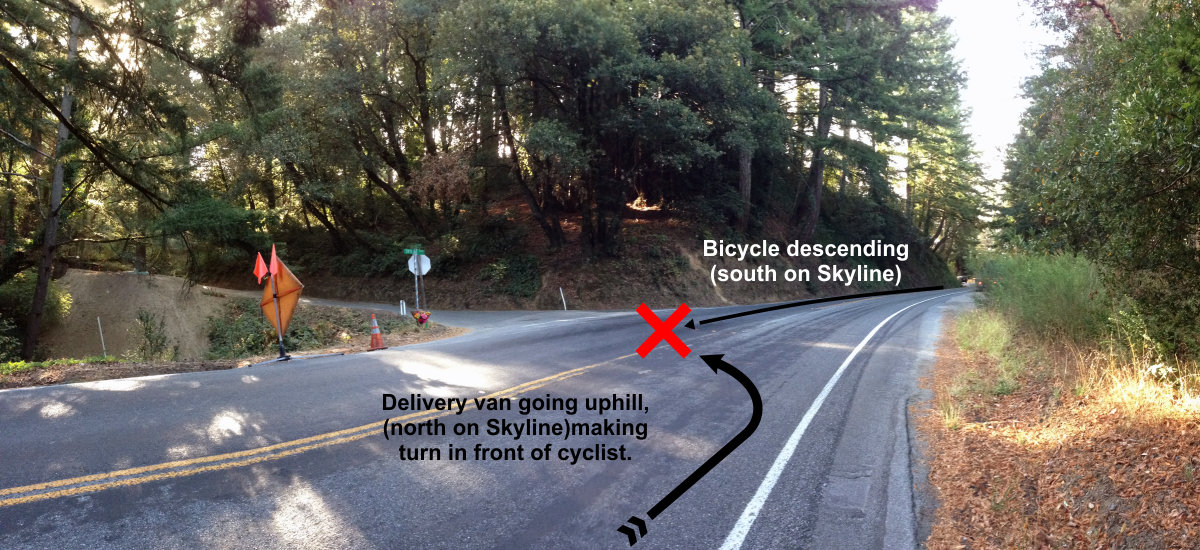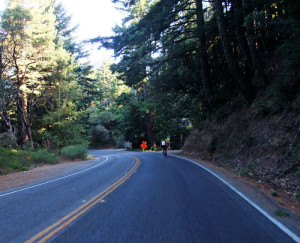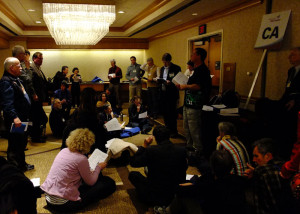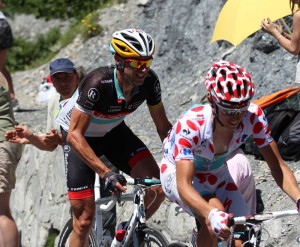
I’ve ridden this stretch of road literally 2000+ times, every single Tuesday & Thursday morning, for the past 25+ years. Any close calls in all that time? None. We watch for cars turning from Elk Tree Road onto Skyline, since you can’t know for sure that they’ve spotted you and are going to wait until you pass before heading across the road. But that’s not the scenario for the accident 9/18/2013; it was a delivery truck coming up Skyline, not from the side road, and it made a turn across Skyline into her (location in Google Maps).
I rode up there with my son to check it out this morning, as I always do when there’s a serious accident involving a cyclist on “my” roads, and when I have questions that haven’t been answered. And in similar past situations, what I have seen myself is often at odds with the “official” write-up. Unless you have a cyclist on the scene during the investigation, assumptions (leading to conclusions) occur that are often at odds with reality.

It’s nearly impossible to come up with a scenario in which anything Joy Covey did was at odds with legal operation of a bicycle (or any other vehicle). She was descending a stretch of Skyline where the grade is such that you can coast at a reasonable speed (26-33mph) but it’s nearly-impossible to exceed the speed limit of 40mph without really working it, and it’s not a section of road where people do that (coming just after a small climb so you’re tired and happy to take it easy for a bit). We may even know her speed with near-100% accuracy, since she’s on Strava and probably recorded the ride. Looking at her past Strava rides, I’m guessing they’ll find she was traveling at 32mph or less at that point; her prior 3 rides were 32, 32 & 31.7mph. This is not a speed demon terrorizing others on the road. At that speed, there’s about 6-7 seconds during which she was visible to a car at the Elk Tree Road intersection. That’s plenty of time to safely make a go/no-go decision on making the left-hand turn across oncoming traffic. Obviously, if there was oncoming traffic, you don’t make the turn.
But the driver DID make that turn. Did he do so without looking? Did he come up the road without stopping? Making the reasonable assumption that he had no malice towards cyclists, why did he make that turn? Did he see her but think cyclists travel much slower than 32mph on a descent, thus terribly misjudging things? I don’t know. The only thing I know is that I’m not going to believe this to be an “unfortunate accident” that just happened, while operating a vehicle legally. We are required to be aware of our surroundings when driving, when cycling. That doesn’t change that something was an “accident” but it does require acceptance (or deliverance) of responsibility on the part of the person who caused it.
Could Joy Covey have done something to prevent it? I don’t know, and even if she could have, even if, lit up like a Christmas Tree and blasting an air horn could have prevented it, that doesn’t change who’s at fault, and it’s reasonable to operate a bicycle without retinal-burning lights and ear-splitting air horns. And yet people will use the availability of flashing bright lights to essentially blame the victim if she wasn’t riding with them. I don’t know if she was; the odds would favor that she wasn’t running with daytime flashing lights, because most cyclists don’t.
And this is where it gets very, very frustrating. I strongly believe in bright daytime flashing lights; I think they greatly enhance the likelihood of your being seen on the road, but not for the reasons people think. Not because it makes you more visible at any given time, but because it increases the length of time you might be visible. Why is it important to be visible a very long way away and not just 500ft or so (which would be plenty of time for someone to notice you and react accordingly)? Because people “zone out” from time to time while driving, and if they happen to “zone out” during that critical last 500ft, bad things can happen. And please let me know if you haven’t, at some point, been driving along and suddenly realized that you can’t play back the last 30 seconds in your mind, because somehow you were on autopilot, going through the motions but not really being aware.
But I can’t send out an email telling people to make themselves more visible, suggesting that they use bright daytime flashing lights and wear brighter clothes, because it would seem both opportunistic (because after all I sell such things) and also give people a chance to blame the victim.
The saddest irony is that Tuesday night I saw a story about how dangerous motorcycling is, with very scary statistics, and reflected upon how much safer bicycling is. I was thinking about writing something up to help calm those who are afraid to get out there on the roads because they know someone who got hit, or have been hit by a car themselves. I was going to point out that I’ve ridden well over 500,000 miles with only two minor incidents with cars, and how much more likely it would be that the same number of miles driving might have involved as many accidents but possibly with much worse outcomes.
I was going to write how we are not helpless on the roads; how we survive in part by predictable behavior (which starts with stopping at stop signs and lights and following traffic rules in general) and also through things like flashing headlights and tail lights, even in the daytime. I still believe those things. I still leave the garage (as I did this morning) not thinking that I’m doing something I might not come back from, that I might be leaving my wife and kids and business without me. I still feel safer when I’m on my bike, in control, than I do when I’m in a car that somebody else is driving. Because I do have control, because I have influence over things that affect my safety when riding my bike, even on busy roads.
But think how awful all of that would sound to a friend of Joy Covey’s, or her son. Or one of my kids, if something happened to me. Sure, they’d be dragging out the cliché about how I died doing something I loved, but they’d also be asking themselves what if it wasn’t so important that I rode that day? –Mike–
Added thought: How would this have played out in the media if it had been a car that the delivery van had turned into, and not a bike? Would anyone have questioned that the driver of the car that had been plowed into might be at fault?

